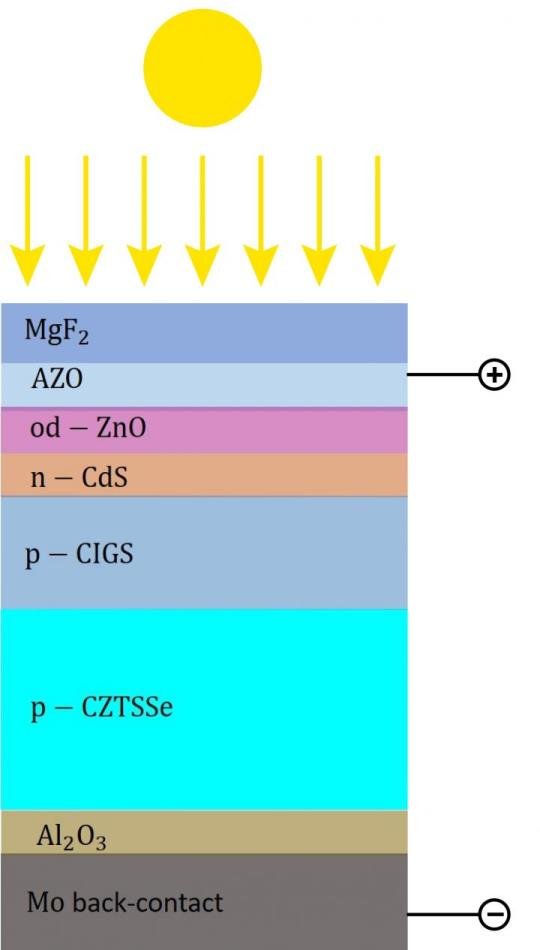Sep 16 2020
Although solar cells have advanced to a large extent, economical, thin film solar cells are yet to catch up with the more costly, crystalline solar cells in terms of efficiency.
 Schematic of a double thin film layered solar cell. The sun enters at the top and reaches the CIGS and CZTSSe layers that absorb the light and create positive and negative particles that travel to the top and bottom contact layers, producing electricity. Image Credit: Akhlesh Lakhtakia, The Pennsylvania State University.
Schematic of a double thin film layered solar cell. The sun enters at the top and reaches the CIGS and CZTSSe layers that absorb the light and create positive and negative particles that travel to the top and bottom contact layers, producing electricity. Image Credit: Akhlesh Lakhtakia, The Pennsylvania State University.
Scientists have recently proposed that using two thin films made of different materials could offer a solution for creating economical, thin-film cells that have around 34% efficiency.
“Ten years ago I knew very little about solar cells, but it became clear to me they were very important,” stated Akhlesh Lakhtakia, Evan Pugh University Professor and Charles Godfrey Binder Professor of Engineering Science and Mechanics, The Pennsylvania State University (Penn State).
Exploring the field, Lakhtakia learned that scientists looked at the solar cells from two sides, the optical side—to see how the Sun’s light is captured—and the electrical side—to see how the captured sunlight is changed into electricity.
Optical researchers aim to improve light capture, while electrical scientists help to improve conversion to electricity, both sides streamlining the other.
I decided to create a model in which both electrical and optical aspects will be treated equally. We needed to increase actual efficiency, because if the efficiency of a cell is less than 30% it isn’t going to make a difference.
Akhlesh Lakhtakia, Evan Pugh University Professor and Charles Godfrey Binder Professor of Engineering Science and Mechanics, The Pennsylvania State University
The scientists presented their results in the latest issue of Applied Physics Letters.
Lakhtakia, a theoretician, does not create thin films in a laboratory but instead develops mathematical models to test the prospects of materials and configurations so that others can explore the results. The issue, according to him, was that the mathematical structure of improving the electrical and the optical are highly different.
Solar cells seem to be uncomplicated devices, Lakhtakia explained. A distinct top layer permits sunlight to fall on an energy conversion layer. The material, which was selected to change the energy, absorbs the light and creates streams of positively charged holes and negatively charged electrons that travel in opposite directions.
The differently charged particles are shifted to a bottom contact layer and a top contact layer that guide the electricity out of the cell for utilization. The quantity of energy produced by a cell is determined by the amount of sunlight captured and the capacity of the conversion layer. Various materials react to and transform light of varying wavelengths.
I realized that to increase efficiency we had to absorb more light. To do that we had to make the absorbent layer nonhomogeneous in a special way.
Akhlesh Lakhtakia, Evan Pugh University Professor and Charles Godfrey Binder Professor of Engineering Science and Mechanics, The Pennsylvania State University
The unique method was to employ two types of absorbent materials in two different thin films. The team selected commercially available copper indium gallium diselenide (CIGS) and copper-zinc tin sulfur selenide (CZTSSe) for the layers. By itself, the efficiency of CIGS is around 20%, while that of CZTSSe is around 11%.
Both these materials function in solar cells because they have the same structure. In addition, the materials have almost the same lattice structure, and therefore, they can be grown on top of the other. They even absorb various frequencies of the spectrum so they should be able to boost efficiency, according to Lakhtakia.
It was amazing. Together they produced a solar cell with 34% efficiency. This creates a new solar cell architecture—layer upon layer. Others who can actually make solar cells can find other formulations of layers and perhaps do better.
Akhlesh Lakhtakia, Evan Pugh University Professor and Charles Godfrey Binder Professor of Engineering Science and Mechanics, The Pennsylvania State University
According to the team, the following step would be to develop the solar cells experimentally and explore the kind of options that will deliver the final, ideal answers.
The study’s first author is Faiz Ahmad, a doctoral student in engineering science and mechanics at Pennsylvania State University. Peter B. Monk, Unidel Professor of Mathematical Sciences from University of Delaware filled out the research team.
The study was funded by the National Science Foundation.
Journal Reference:
Ahmad, F., et al. (2020) Double-absorber thin-film solar cell with 34% efficiency. Applied Physics Letters. doi.org/10.1063/5.0017916.